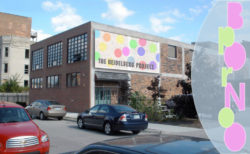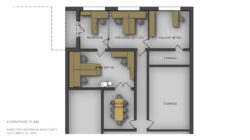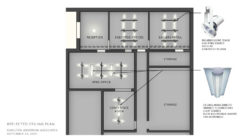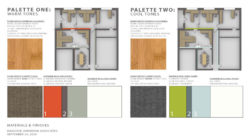PRO BONO \ THE HEIDELBERG PROJECT
pro bono publico – for the public good or well being, and more commonly understood in the world of professional services as ‘free’.
DEFINING PRO BONO. We all understand disparities in wealth and access to professional services. To some, these disparities compel a moral imperative to provide professional services to under-served communities. Many architects regularly perform pro bono services for a variety of ends. While certain firms focus on needs of the international community, such as Japanese architect Shigeru Ban and his disaster relief housing for Japan, Turkey, and India, others focus on issues specific to the United States. Auburn University’s Rural Studio has been designing and building housing and civic buildings in rural Alabama since 1993, while Yale University has an even longer tradition of volunteering their design/build services to their local community. While globalization has increased the reach and scope of the architect, it has also brought to the forefront the major issues that plague our societies. A great need exists globally and locally, and architects are more capable than ever to affect change.
FOR-PROFIT ENGAGEMENT. Even as a number of non-profit firms work diligently across the country, almost exclusively for other non-profit organizations, the for-profit environment has yet to wholly embrace the social and moral side of architecture. Public Architecture, an organization founded in 2002, has initiated a 1% commitment for all for-profit architecture firms. They strive to commit the resources available within the field of architecture to act as advocates for social justice, thereby improving communities locally and globally. “The 1% program of Public Architecture connects nonprofit organizations in need of design assistance with architecture and design firms willing to donate their time on a pro bono basis.” Public Architecture speculates, “If every architecture professional in the U.S. committed 1% of their time to pro bono service, it would add up to 5,000,000 hours annually – the equivalent of a 2,500-person firm, working full-time for the public good.”
Unfortunately, the culture of architecture discourages such altruistic activities. Instead, the profession is largely concerned with those projects that have high profiles, huge budgets, and the associated lucrative fees. These projects provide the architect with the ability to explore their ‘creative genius’ and create the iconic buildings that can place them among the stars of the profession. Clay Risen, in his piece ‘Fix the Pritzker’, calls for a dramatic reversal, for architects to begin to celebrate advocacy and justice instead of the lofty ideals of the world’s most brilliant designers. While legal and medical professions have already established professional frameworks guiding their pro-bono practices, architects are just beginning to define how to work in this way. Currently, the American Institute of Architects is working to adopt a series of professional guidelines for firms providing pro bono services, legitimizing such practices amongst for-profit architecture firms.
INVOLVEMENT. Architects possess a vast professional skill set that would benefit many agencies with pro bono services. In the most traditional sense, architects are equipped to creatively solve problems associated with the built environment, from housing and community centers to churches and civic space. These efforts have significant ability to provide meaningful change to people’s lives. On a broader scale, architects understand complex problems by relying on their humanistic education, comprehension of multi-scale built form, and real world experiences. Drawing from these sources, architects derive solutions that respond to public policy, economics, urban development, financing and social issues. Lastly, one of the architectural profession’s foremost responsibilities is coordinating efforts. Typically effective at managing diverse teams of consultants, contractors, and owners, architects solve problems burdened by competing interests. Simply stated, architects can solve complicated issues with complex goals by coordinating disparate parties toward a common vision.
A CASE STUDY. HAA recently performed pro bono services to assist a Detroit non-profit group, The Heidelberg Project. Their most recent expansion and proposed development required a new, larger office space. HAA collaborated with the Heidelberg team to design the new space; laying out floor plans, addressing lighting and selecting interior finishes. Understanding their limited budget, the team expediently identified cost effective solutions. Most importantly, HAA provided flexible solutions that adapt to current and future needs. As Heidelberg continues to grow, the new offices can expand and evolve. The project’s pro bono efforts reflect HAA’s commitment to utilize our knowledge to assist great organizations in need within our community.
In and of itself, The Heidelberg Project (click here for an interactive map)is a remarkable story chronicling more than two decades of effort by artist Tyree Guyton. Located on the East side of Detroit, his work at Heidelberg largely repurposes commonly discarded objects as sculptural installations within abandoned lots and vacant houses. The original objects were collected through a neighborhood cleanup effort that began with Tyree and his father. His efforts served two purposes: they cleaned up his neighborhood and drew attentive visitors, which in turn, provided greater public safety. On a national level, the work is commonly understood in the political context of abandonment, poverty, and discrimination in the city of Detroit and beyond. The project gained even greater attention after the City of Detroit demolished several of the project’s installations. Later, Guyton won a civil suit against the city, protecting his work within the neighborhood. Over the years, The Heidelberg Project has won many awards and serves as one of the most influential public art installations in the urban environment. Most prestigiously, the project represented the United States at the 2008 Venice Architecture Biennale.
While The Heidelberg Project initially illustrates the positive impact of a created vision donated to an underserved community, the continued sequence of professionally donated efforts truly exemplifies the power of pro-bono.








